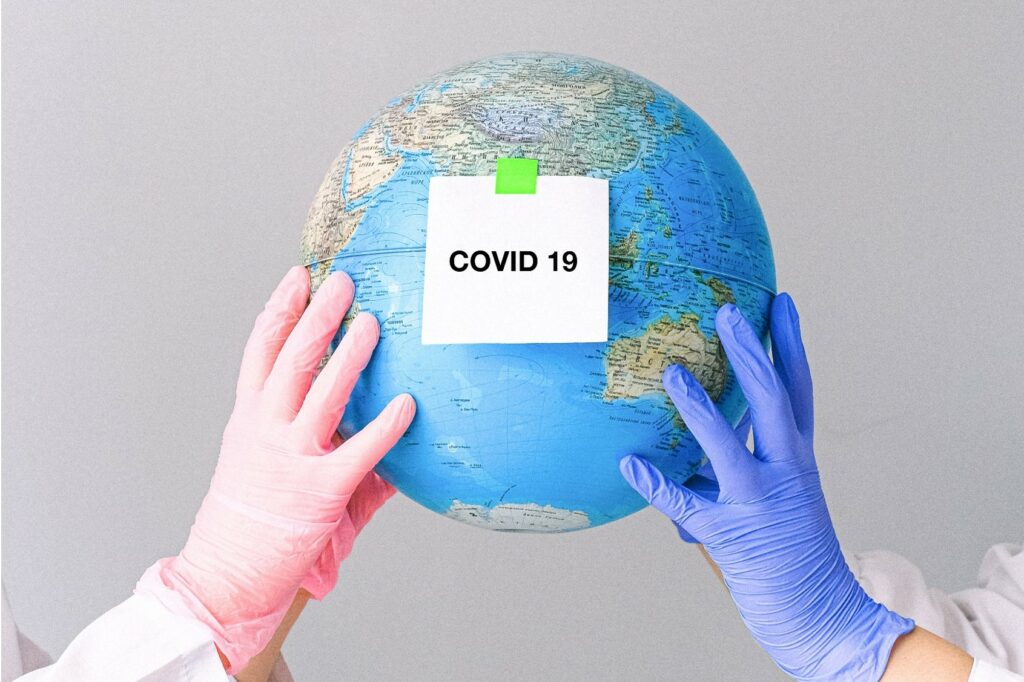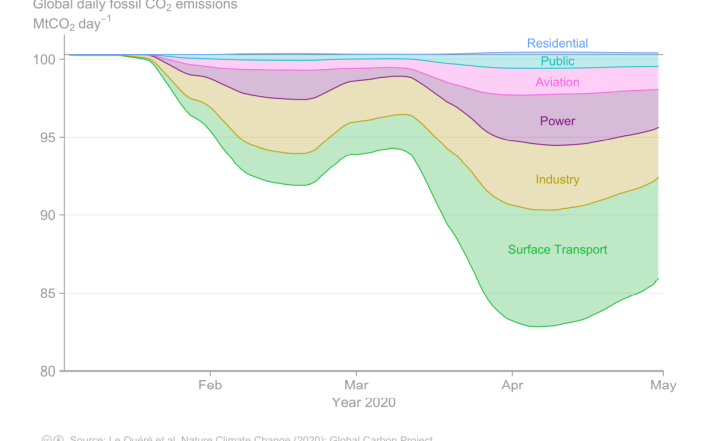COVID-19 the Anti-Hero of our time

In 2020 the world was subjected to a major destructive event known as the COVID-19 pandemic. The pandemic was a result of exposure to the SARS-COV-2 virus (NAVEEN KUMAR; JITENDRA, 2020). The origin of the pandemic was traced back to the Huanan seafood wholesale wet market in Wuhan China (SALATA; CALISTRI; PAROLIN; PALÙ, 2020). The pandemic has resulted in millions of people being infected globally and leaving more than 5 million dead. (NAVEEN KUMAR; JITENDRA, 2020). Despite the major threat to health, the pandemic has also caused devastation in areas such as the economy, and society. Albeit the devastating effects of the COVID-19 pandemic, it should be noted that it can be seized as an opportunity in combating climate change by integrating “building back greener” policies into COVID-19 recovery plans to catalyze the transition to a greener and sustainable future (BRANTON; WALSH; ROSE, 2022). Building back greener can be applied across sectors such as agriculture, livelihoods, transport, housing, education, and others. This blog will focus on how the COVID-19 pandemic has contributed to and could contribute to the transition of more sustainable transportation systems and the importance of doing so (GFDRR, 2020).
How has COVID-19 benefited the transition to sustainable transportation systems?
At the beginning of the COVID-19 pandemic great reductions in GHG emissions were observed as a result of the reduced surface transport, reduced aviation, and reduced power generation that occurred because of global lockdowns (QUERE, 2020). According to (QUERE, 2020)aviation decreased by 75%, surface transport decreased by 50% and power generation by 15%. The peak decrease in GHG emissions was recorded at 17%, and emissions from surface transport accounted for 43% of this decrease this can be seen from the graph below. This data highlights the great opportunities that come with transforming the surface transportation sector and its role in building back greener for a more sustainable and resilient future (QUERE, 2020) It was highlighted in 2018 by the IPCC report how essential reducing GHG emissions was in order to maintain global warming to a temperature of 1.5℃ above pre-industrial levels. The report highlights that to reach this target humans would have to reduce their C02 emissions by 45% by 2030, transitions in many sectors including transport is essential to reaching this goal (Paul Slovik).

The COVID-19 pandemic revealed that means of mobility in cities can be a lot more diverse than previously believed. As a result of the COVID-19 pandemic more than 1400 km of newly formed cycle lanes, traffic calming measures and car-free streets have been implemented in European cities (AGENCY, 2021). The pandemic inspired city leaders to change mobility infrastructure in order to facilitate micro-mobility means of transportation, for example Paris announced the devotion of 50km of lanes reserved for cars to bicycles and plans to invest $325 million to update its cycling network, and Milan transformed 36km of streets previously used for cars to walk and cycling lanes (HEINEKE; MOLLER; WU; KAMPSHOFF, 2020). Along with the pandemic promoting the use of green areas, and use of micro-mobility means of transport such as bicycles, and electric scooters the pandemic also affected consumer preference and behaviour in relation to means of transport. A survey conducted by(HEINEKE; MOLLER; WU; KAMPSHOFF, 2020)concluded that consumer preference for travel has switched from time to destination cost convenience to lessened risk of infection as their major concern. This is a result of millions of individuals working from home, and their journeys are becoming longer and less frequent (MILLER; BATRA, 2021). All of these factors ranging from reduced GHG emissions by means of alternative transportation vehicles such as bicycles, promotion of electrical vehicles and changes in consumer preference are information learned from the pandemic that can be used to implement permanent changes in the transportation sector in order to build back greener.
Opportunities exposed by COVID-19
Opportunities that have risen and could be seized as a result of the pandemic for transportation systems include the permanent reallocation of road space to walking and cycling lanes to enable better accessibility around city areas, allowing for more versatile mobility options such as electric scooters, bikes, and mopeds, which may reduce individuals purchasing ICE vehicles. It should be noted that permanent reallocation, and infrastructural changes in transportation systems will require regulatory intervention and funding in order for it to remain permanent and to succeed (AGENCY, 2021). The pandemic also may have a great influence on the purchasing of electric vehicles (EV) in the future and may be the catalyst to begin the EV boom sales (MILLER; BATRA, 2021). In the latest EY mobility lens consumers index survey it was found that 78% of potential car buyers said that COVID-19 heightened their level of environmental awareness, which could lead to higher EV purchases, which would result in decreases in GHG emissions (MILLER; BATRA, 2021). In relation to electric vehicles a potential opportunity for building back greener could be for governments to develop policies and provide incentives to aid the automotive industry to encourage EV car sales, for example in Germany purchase-price subsidies for new EV’s range from 16,000-22,500 depending on the vehicle, this may aid in the lowering of emissions from surface transportation (HEINEKE; MOLLER; WU; KAMPSHOFF, 2020).
It cannot be denied that the effects of the COVID-19 pandemic have negatively impacted the progress to meeting most of the sustainability development goals for the year 2030. There are some SDG’s that could potentially benefit from the aftermath of the COVID-19 pandemic, for example the SDG 11 which is for the development of sustainable cities. This SDG aims to provide access to safe, affordable, accessible, and sustainable transportation systems for all, by expanding public transport, and the reduce the adverse per capita environmental impact of cities. (Spillane, 2021). As previously discussed COVID-19 has led to the promotion of micro-mobility options and has increased the interest in electrical vehicles, which would aid in reducing the environmental impacts of city transportation (PRAJAL PRADHAN ; DAYA RAJ SUBEDI ; KHATIWADA; et al., 2021). The pandemic has created a certain anxiety around public transport that may reduce the use of public transportation which is undesirable in the long-term. The opportunity to implement hygiene and safety measures on public transport is essential so that individuals feel safe travelling via public transport and will further promote the transition away from ICE vehicles, and these practices have been learned from COVID-19. The opportunity to incorporate green recovery plans and funding with COVID-19 recovery plans could support a wide range of sustainability objectives such as the transition to sustainable transportation systems, and aid in catalyzing the transition to sustainable city transportation and other major benefits such as improved air quality, reduced GHG emissions and development of sustainable cities (AGENCY, 2021). In conclusion despite the devastation COVID-19 has brought us over the past two years, it has potential to be the underdog for changing our transportation systems to more sustainable, resilient, and environmentally friendly systems, that would have prolonged benefits for both humans and the planet.
Bibliography:
AGENCY, E. E. Urban sustainability in Europe: Opportunities for challenging times., 2021. Disponível em: https://www.eea.europa.eu/publications/urban-sustainability-in-europe. Acesso em: European Environment Agency.
BRANTON, J.; WALSH, D.; ROSE, A. Build Back Greener: Government announces significant public funding package to help the UK reach its ambitious net zero emissions target. Lexology, 2022. Disponível em: https://www.lexology.com/library/detail.aspx?g=46ac5086-3c5c-483d-8a21-daf88fee79bc.
GFDRR. 2020.
HEINEKE, K.; MOLLER, T.; WU, T.; KAMPSHOFF, P. From no mobility to future mobility: Where COVID-19 has accelerated change. McKinsey & Company., 2020. Disponível em: https://www.mckinsey.com/industries/automotive-and-assembly/our-insights/from-no-mobility-to-future-mobility-where-covid-19-has-accelerated-change.
MILLER, R.; BATRA, G. How did the global crisis pave the way for EV sales? EY, 2021. Disponível em: https://www.ey.com/en_gl/automotive-transportation/how-did-a-global-crisis-pave-the-way-for-ev-sales. Acesso em: 01/01/2022.
NAVEEN KUMAR, A.; JITENDRA, M. COVID-19 and importance of environmental sustainability. Society for environmental sustainability., 3, p. 117-119, 2020.
PRAJAL PRADHAN ; DAYA RAJ SUBEDI ; KHATIWADA, D.; , K. K. J. et al. The Covid-19 pandemic not only poses challenges, but also opens opportunities for sustainable transformation. Earths Future, 9, n. 7, 2021.
QUERE, L. Impact of COVID-19 on CO2 emissions. 2020.
SALATA, C.; CALISTRI, A.; PAROLIN, C.; PALÙ, G. Coronaviruses: a
paradigm of new emerging zoonotic diseases. 77, n. 9, 2020.